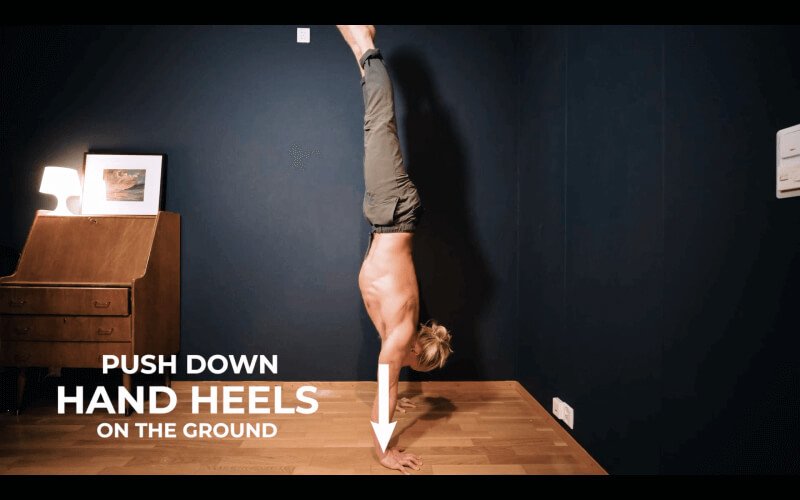Prevent under balancing (falling backwards) your handstand!
In my last post we went over how to use your fingers to prevent yourself from falling forward while in a handstand. In this one, I am going to teach you how to correct your balance and prevent yourself from falling backwards! :) I will go over some important form cues to keep in mind and provide you with some practicable exercises for improving your ability to use your ‘hand heels’, as I call them, and ultimately bring much better balance to your handstand.
First off, let’s clear something up. Wtf is a hand heel?! When I use the word ‘hand heel’, I am referring to the bottom part of your palm. It is this part of your hand that we need to focus on when preventing ourselves from falling backwards while in a handstand, among other things.
When we are upside down, there are two ways of transferring weight over to our hand heels:
The first way is to slightly bend our elbows and lean forwards in our shoulders, as pictured. This method is not the most efficient method. It requires quite a bit of strength, and so it will tire you out faster.
To corect large imbalances, the first method of preventing yourself from falling backwards is okay. But it’s not the most efficient method.
It is, however, quite helpful for correcting large imbalances. You can also use it to correct small imbalances by only slightly bending our elbows, and only slightly leaning forward in the shoulders.
The second way to transfer weight to our hand heels and adjust our balance when falling backwards is to rotate your shoulders inwards. The way that you can think of this is, to try and make your elbow pits (another nifty word) face each other. Doing this will transfer more weight over to your hand heel and adjust your balance. One thing to note for this method, is that you should already be able to elevate your shoulders to put it to use.
So, if you already have control of your shoulders - you’re able to elevate them and inwardly rotate them - use the second method instead of the first, as it’s much more efficient.
Take a look to get a more visual description on what I mean regarding inwardly rotating your shoulders
Look closely at my shoulders and you can see they are inwardly rotating.
Complete, Structured Handstand Program
In my app the Movement Trybe you will find a structured program to follow. There are 3 programs dedicated solely to the handstand. Handstand 2 program is focused more on balancing the handstand and reaching your first 10 second handstand, and if this post is relevant to you, that’s probably the one to go with.
Whichever method you decide to go with, the most important thing is that your weight is transferred to your hand heel so that your balance is adjusted and you don’t fall backwards.
Handstand drills
Let’s go over some drills on how to practice using your hand heel to balance your handstand:
Wall push in/outs
With your back facing the wall, rather than using your feet to push out from the wall, try to use your fingers. Then, to get your feet back onto the wall, push with the other side - your hand heels. This drill trains both sides of your hands - your fingers and your hand heels - and can be done for repetitions.
With your back facing the wall, rather than using your feet to push out from the wall, try to use your fingers.
Continuous balance
With the wall nearby, in case it’s needed, you can start to keep continuous balance by using your hand heels as well as your fingers.
Continuous balance practice: trying to keep balance as long as you can with a wall nearby only if you need it.
I recommend using both of these drills. The 1)wall push in/outs to isolate using your fingers and your hand heels, and bringing these techniques together to practice 2)continuous balance.
Let’s quickly summarize:)
“How to stop falling backwards when I handstand”
Learn to push into the ground with your hand heel to bring your legs forward.
For large imbalance, bend your elbows and lean forwards in your shoulders.
For small imbalances, rotate your shoulders inwards. The way that you can think of this is, to try and make your elbow pits (another nifty word) face each other. This method is more efficient.
Practice using your hand heel with a focused exercise: wall push ins. Using the wall for assistance, and with your back to the wall, enter a handstand. With intention, bring your feet to the wall by pushing in with your hand heel.
Practice doing wall push ins/outs as reps. As well, practice continuous balance with the wall nearby.
Go check out the handstand 2 program on my app now and take your training to the next level :)
Hope this article was helpful for you, if you’ve got any questions feel free to leave a comment here, on the YT channel, or on my IG. Take care movers!! :)













